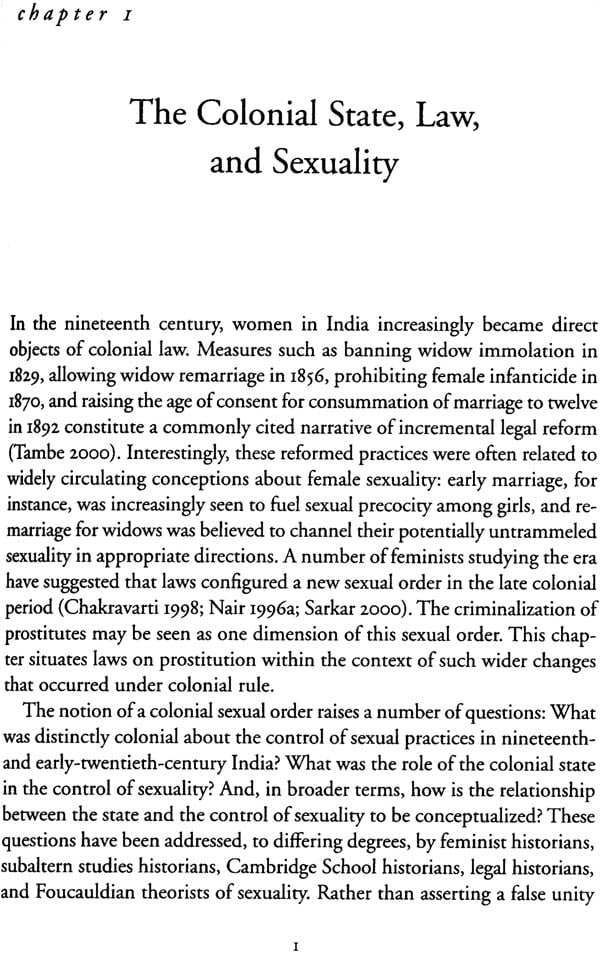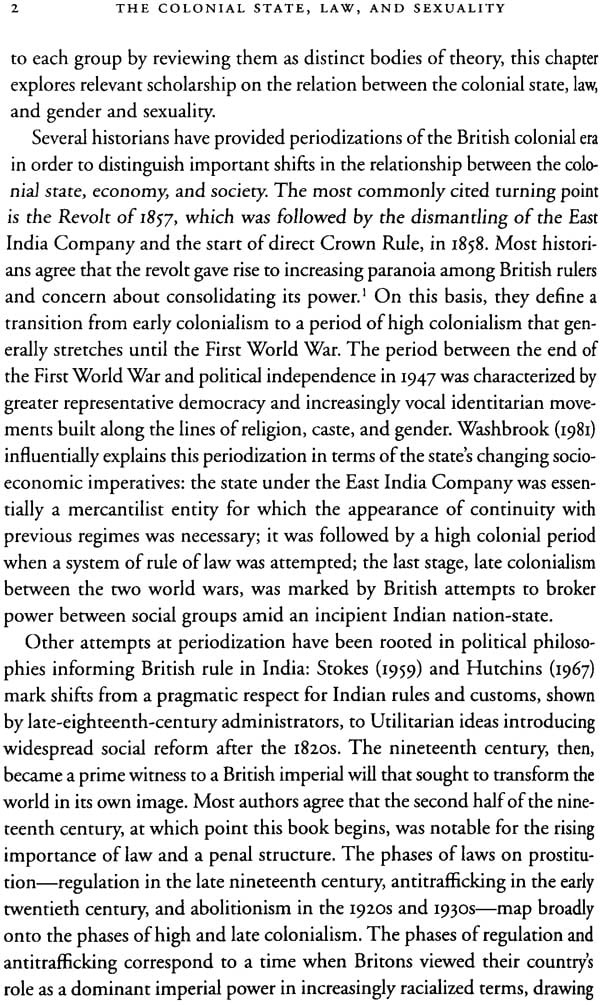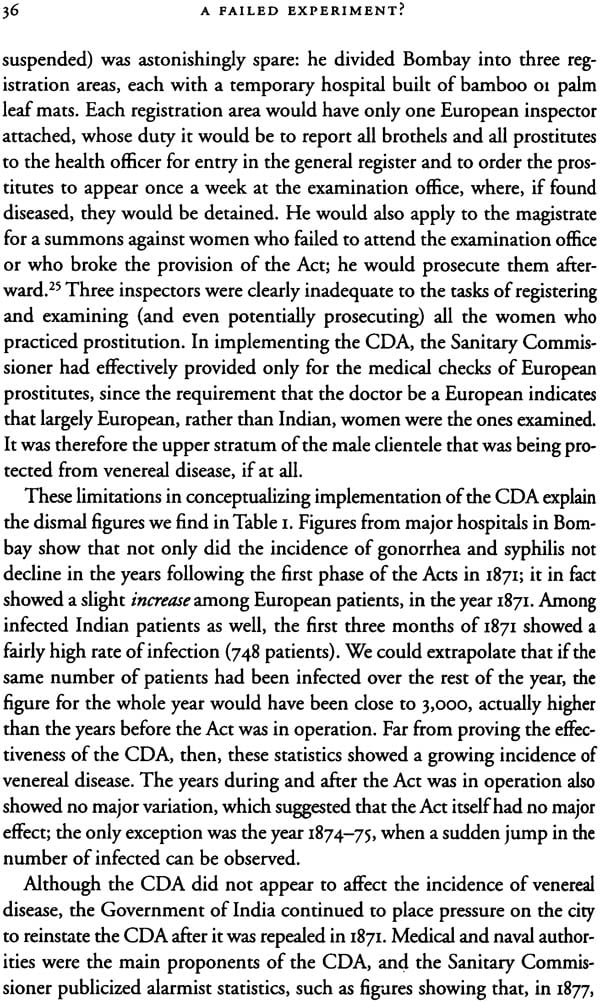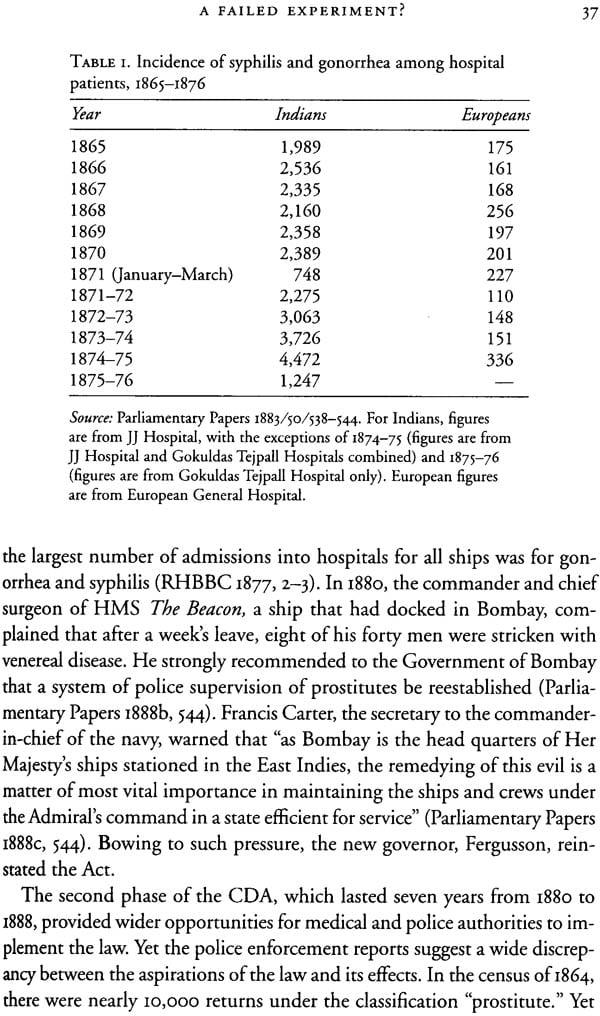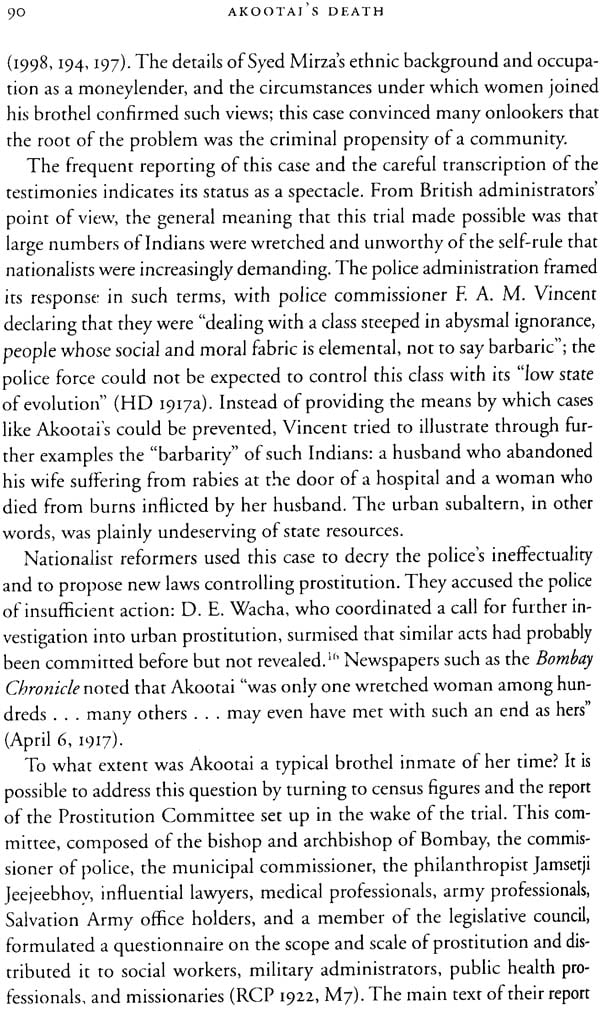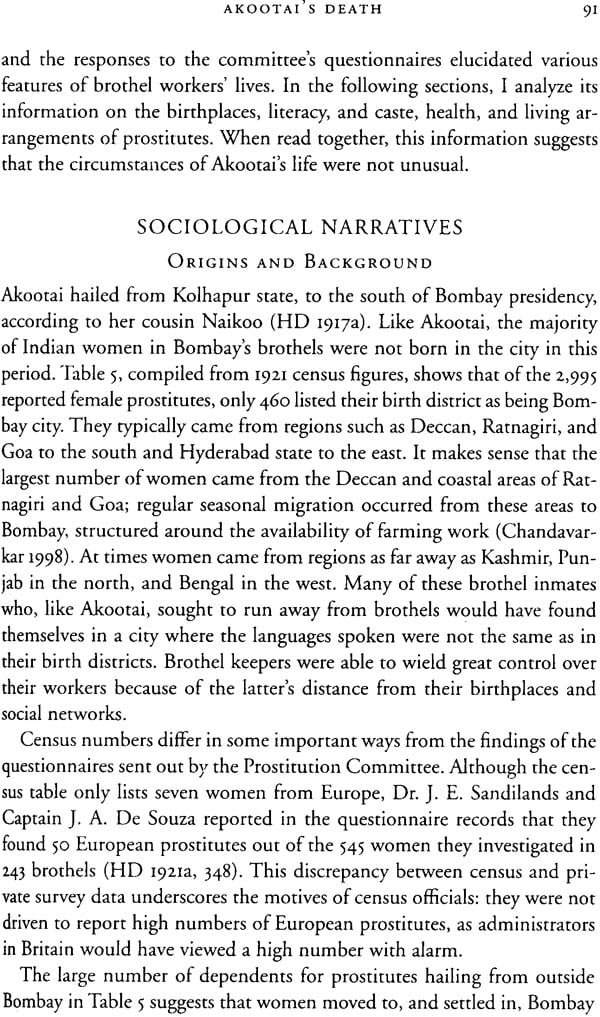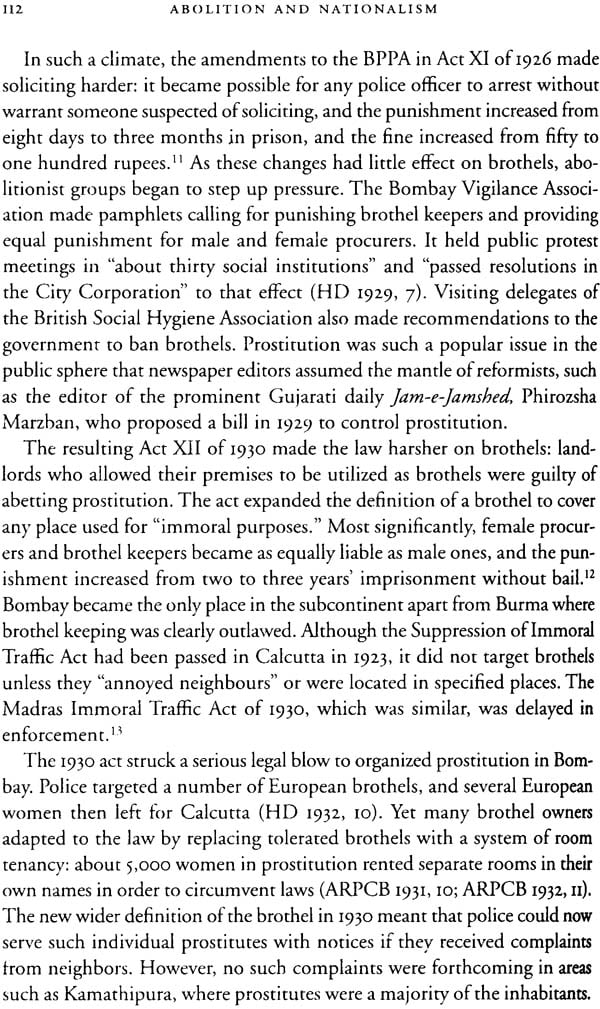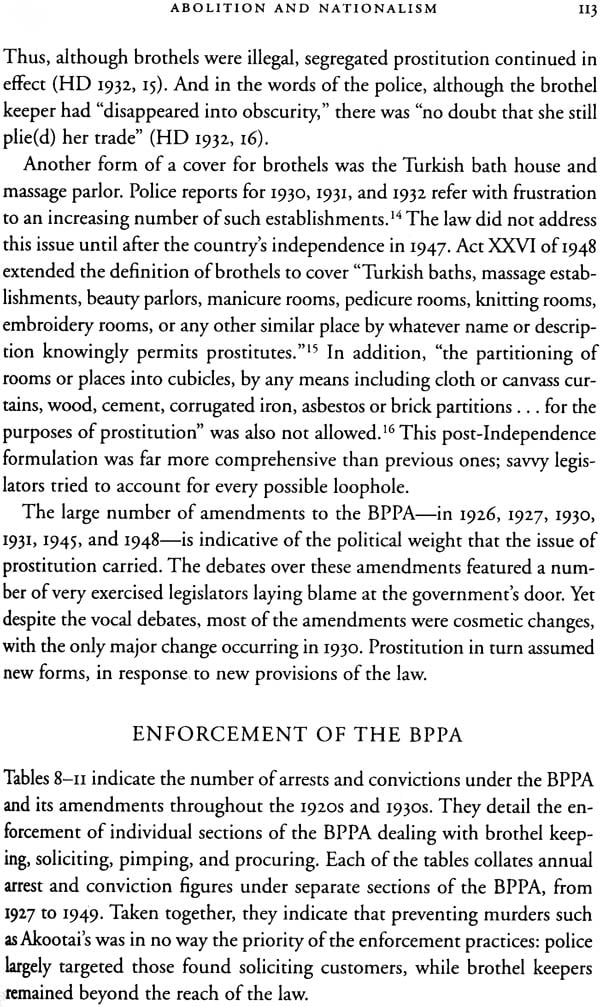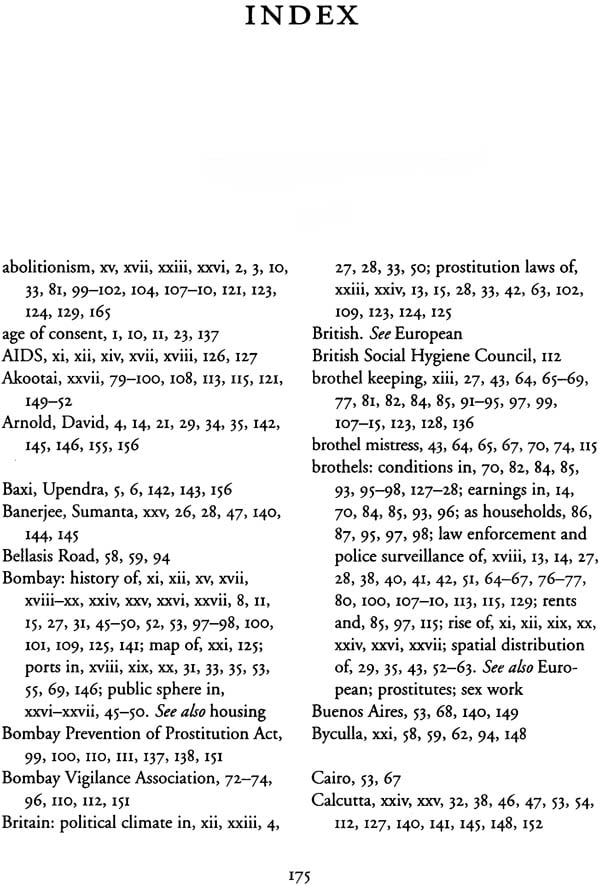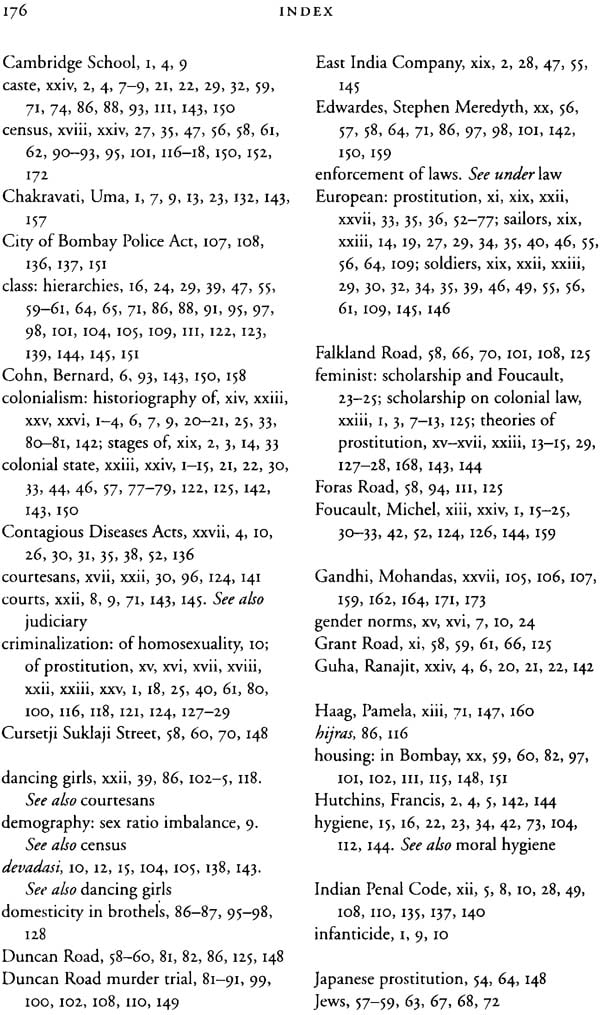
Codes of Misconduct (Regulating Prostitution in Late Colonial Bombay)
Book Specification
| Item Code: | NAJ286 |
| Author: | Ashwini Tambe |
| Publisher: | Zubaan Publications |
| Language: | English |
| Edition: | 2009 |
| ISBN: | 9788189884420 |
| Pages: | 200 |
| Cover: | Hardcover |
| Other Details | 9 inch X 5.5 inch |
| Weight | 380 gm |
Book Description
About the Book
Ashwini Tambe’s remarkable study focuses on the relationship between forms of prostitution, discourses of law making, and law enforcement practices.
Across the nineteenth and early twentieth centuries, the colonial government in Bombay city formulated laws on prostitution that were enormously repetitive. Activities such as soliciting men, pimping and procuring women and girls for prostitution were banned in identical ways in multiple eras. Across the same hundred years, commercial sex grew vast in scale, and Bombay became a mode in a transnational sex trade circuit.
This book argues that while the expansion of Bombay’s sex trade over the past century might suggest that laws were simply ineffectual, law making was instead a productive process that sustained particular forms of prostitution.
In examining this dimension of colonial governance, Tambe evaluates the uses and limits of Foucault’s approach to law and sexuality.
Tambe demonstrates that regulation and criminalization of prostitution were not contrasting state approaches to prostitution, as is often assumed, but rather, different facets of state coercion.
About the Author
Ashwini Tambe is Assistant Professor of Women’s Studies and History at the University of Toronto. Her research focuses on colonial South Asia, gender and sexuality studies, social theory and global political economy. She has co-edited a volume titled The Limits of Colonial Control in South Asia on subaltern mobility in the Indian Ocean region (Routledge 2008), and her essays have appeared in journals such as Feminist Studies, Gender and Society, International Feminist Journal of Politics, Gender, Place and Culture, and Social Scientist.
Introduction
One July afternoon in 2004, while conducting an interview with a public health professional in Mumbai about the city’s sex trade, I experienced an uncanny feeling of displacement. I was speaking to Dr. I. H. Gilada, a principal voice in AIDS-control circles in India, at his clinic off Grant Road. As he outlined his proposals for regulating prostitution, I found his words echoing, almost verbatim, those of a doctor called K. S. Patel who had worked at a venereal diseases hospital in the same area in the early 1920S.2 I had come across Dr. Patel’s confident recommendations to the colonial government just a few days earlier in a file preserved at the Maharashtra State Archives. His call for compulsory health checks and residential segregation of prostitutes, and his resigned acceptance of men’s putative sexual needs, now spoke to me through the voice of a living person. Dr. Gilada, too, was calling for demarcating a zone for licensed brothel workers where they would receive regular medical checks. He argued that the demand for commercial sex could not be wished away and that the only way to protect the wider citizenry from venereal disease was to closely monitor sex workers.
This sense of deja vu is familiar to anyone looking closely at the history of the sex trade in Bombay. Just as police reports in the 1930S complained that massage parlors were a new front for brothels, so also in the early years of the twenty-first century, residents repeatedly expressed fears that the city was witnessing an “invasion” of brothels passing as massage parlors.” Just as Eastern European women settled in Bombay’s wealthier brothels at the turn of the twentieth century because of upheavals in the Russian ghetto, women from former Soviet republics such as Uzbekistan were, at the start of the twenty-first century, to be found working as call girls in Mumbai’s upscale hotels.” Just as police focused on relocating those in the most publicly visible stratum of the sex trade in the 1880s, such as European brothel workers, so also the government in 2005 displayed an inordinate fascination with the spectacle of “bar girls,” the subject of recent films and books.” And just as the British activist Josephine Butler and the Ladies National Association in the 1880s used a campaign on behalf of Indian prostitutes as a means to increase their own political currency within Britain, so too contemporary antitrafficking advocates in the United States use egregious stories from Indian brothels as an emotive device to enlist global support.
Some of these continuities are accidental, but many suggest patterns in the way publics and state officials relate to the sex trade. Perhaps the most interesting continuities are to be found in the realm of lawmaking. Many prostitution-related activities that Indian law rules as offenses remain un- changed in description since the formulation of the 1860 Indi n Penal Code.” And this is not for want of political attention to these measures-nearly identical versions of prostitution laws have been passed over and over, with an astonishing degree of regularity. In some cases, parallels between laws can be found within the span of a single decade. In June 2004, for example, the state governor of Maharashtra (of which Mumbai is the capital city) presented the case for licensing sex workers as a response to the spread of AIDS. The proposal created a furor, and I encountered a variety of contrasting responses to it, but by the end of the year the proposal had receded from public view. Although it had appeared novel, it in fact echoed an almost identical attempt made a decade earlier: in 1994, the proposed Maharashtra Protection of Commercial Sex Workers Act had mandated compulsory registration and medical testing of sex workers. It, too, had commanded great public attention when announced. It, too, died quietly after months of discussion, in the Legislative Assembly. In retrospect, the real purpose of such announcements seemed to be to remind the public of the state’s commitment to a “cleaner” red-light district, rather than to usher in changes in the sex trade. The target of these proposals, in other words, was not prostitution as much as public opinion.
The history of prostitution in Bombay is riddled with such measures. Across the nineteenth and early twentieth centuries, the colonial government formulated laws that were enormously repetitive: activities such as procuring women and girls for prostitution, pimping, and soliciting men for prostitution elicited nearly identical legal measures in multiple eras. Procuring or enticement into prostitution was ruled an offense in I827, I860, I921, and I923; and brothel keeping was targeted in 1860, 1902, 1923, and I930 (see “Chronology of Laws Relevant to Prostitution in Bombay”). In the very decades that saw an intensification of legislation on prostitution, 1860-1930, Bombay’s sex trade grew vast in scale and became part of a cross-national circuit. The remarkable similarity in the moral panic about prostitution in various eras, independent of the actual trajectory of the prostitution in the city, pushes us to speculate that lawmaking served a purpose distinct from its actual effects on the sex trade. Could it be, as Pamela Haag (1999) has observed in the U.S. context, that laws presented a palliative vision of societies freeing themselves of sexual commerce? In other words, could it be that laws achieved discursively what could not be accomplished in actuality? While the expansion of prostitution over the past century might suggest that prohibitionist laws were simply ineffectual, could it be that lawmaking was instead a productive process that voiced and shaped public anxieties? Even more intriguingly, could laws have actually sustained particular forms of prostitution?
At the heart of this book is a methodological argument based on such questions. I argue that the law rarely works in straightforwardly efficacious ways, and that the contexts of colonial lawmaking and law enforcement on prostitution deserve to be treated as having distinct imperatives and as serving important bur separate constituencies. Whereas the process of law-making responded to a variety of public panics, the governing practices of police constables and inspectors, army medical examiners, magistrates, and municipal officials enacted administrative logics of separate, more limited ambitions. In focusing on the discrepancy between the language of law and law enforcement practices, my work departs from a textual approach that focuses principally on analysis, of legal documents and legislative debates. It also challenges linear readings of how laws create effects; in keeping with Foucauldian insights, I assume that prohibitions do not end practices so much as rearrange the relative power of interested actors. In following micropractices of regulation, I am heeding the call of historical sociologists of law such as Mariana Valverde (2003), who remind us that studying the state need not only mean studying exalted national or federal sites but also the more quotidian forms of administrative functioning.
Such a focus on micro practices also opens up a specific perspective on colonial history. While imperial laws and policies were often framed in ways that appeared consistent with social and political currents in metropoles, those who administered and effected policies in colonies were often less committed, and sometimes even opposed, to these currents. Following the manner in which laws were executed then allows us to understand better the heterogeneity and limits of empire. It allows us to see how laws could be appropriated in unexpected ways by local nationalist elites, and also how colonial government functionaries could undermine the coherence and impact of colonial discourses. This book, then, offers the case of laws on prostitution as an argument for understanding imperial processes as more multifarious, and less orderly, than colonial discourses themselves projected.
Contents
|
| Abbreviations | ix |
|
| Introduction: Prostitution and the Law in Bombay | xi |
| 1. | The Colonial State, Law, and Sexuality | 1 |
| 2. | A Failed Experiment? The Contagious Diseases Acts in Bombay | 26 |
| 3. | Racial Stratification and the Discourse of Trafficking | 52 |
| 4. | Akootai’s Death: Subaltern Indian Brothel Workers | 79 |
| 5. | Abolition and Nationalism 100 Conclusion. The Failed Promise of Laws: Contemporary Reflections | 122 |
|
| Acknowledgments | 131 |
|
| Chronology of Laws Relevant to Prostitution in Bombay | 135 |
|
| Notes | 139 |
|
| Bibliography | 155 |
|
| Index | 175 |
